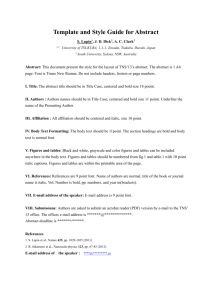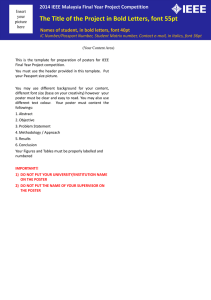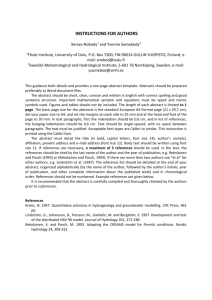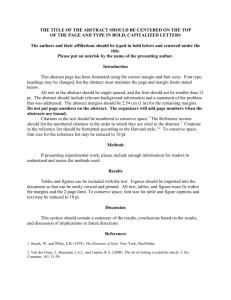WORD Template
advertisement
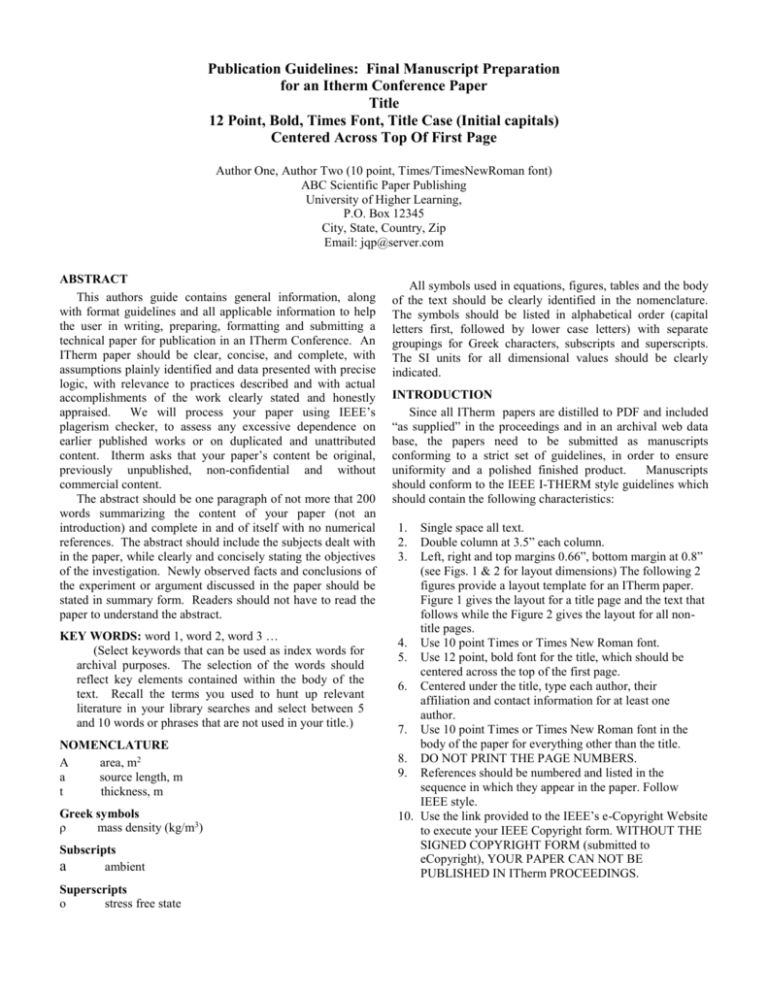
Publication Guidelines: Final Manuscript Preparation for an Itherm Conference Paper Title 12 Point, Bold, Times Font, Title Case (Initial capitals) Centered Across Top Of First Page Author One, Author Two (10 point, Times/TimesNewRoman font) ABC Scientific Paper Publishing University of Higher Learning, P.O. Box 12345 City, State, Country, Zip Email: jqp@server.com ABSTRACT This authors guide contains general information, along with format guidelines and all applicable information to help the user in writing, preparing, formatting and submitting a technical paper for publication in an ITherm Conference. An ITherm paper should be clear, concise, and complete, with assumptions plainly identified and data presented with precise logic, with relevance to practices described and with actual accomplishments of the work clearly stated and honestly appraised. We will process your paper using IEEE’s plagerism checker, to assess any excessive dependence on earlier published works or on duplicated and unattributed content. Itherm asks that your paper’s content be original, previously unpublished, non-confidential and without commercial content. The abstract should be one paragraph of not more that 200 words summarizing the content of your paper (not an introduction) and complete in and of itself with no numerical references. The abstract should include the subjects dealt with in the paper, while clearly and concisely stating the objectives of the investigation. Newly observed facts and conclusions of the experiment or argument discussed in the paper should be stated in summary form. Readers should not have to read the paper to understand the abstract. KEY WORDS: word 1, word 2, word 3 … (Select keywords that can be used as index words for archival purposes. The selection of the words should reflect key elements contained within the body of the text. Recall the terms you used to hunt up relevant literature in your library searches and select between 5 and 10 words or phrases that are not used in your title.) NOMENCLATURE A area, m2 a source length, m t thickness, m Greek symbols ρ mass density (kg/m3) Subscripts a ambient Superscripts o stress free state All symbols used in equations, figures, tables and the body of the text should be clearly identified in the nomenclature. The symbols should be listed in alphabetical order (capital letters first, followed by lower case letters) with separate groupings for Greek characters, subscripts and superscripts. The SI units for all dimensional values should be clearly indicated. INTRODUCTION Since all ITherm papers are distilled to PDF and included “as supplied” in the proceedings and in an archival web data base, the papers need to be submitted as manuscripts conforming to a strict set of guidelines, in order to ensure uniformity and a polished finished product. Manuscripts should conform to the IEEE I-THERM style guidelines which should contain the following characteristics: 1. 2. 3. Single space all text. Double column at 3.5” each column. Left, right and top margins 0.66”, bottom margin at 0.8” (see Figs. 1 & 2 for layout dimensions) The following 2 figures provide a layout template for an ITherm paper. Figure 1 gives the layout for a title page and the text that follows while the Figure 2 gives the layout for all nontitle pages. 4. Use 10 point Times or Times New Roman font. 5. Use 12 point, bold font for the title, which should be centered across the top of the first page. 6. Centered under the title, type each author, their affiliation and contact information for at least one author. 7. Use 10 point Times or Times New Roman font in the body of the paper for everything other than the title. 8. DO NOT PRINT THE PAGE NUMBERS. 9. References should be numbered and listed in the sequence in which they appear in the paper. Follow IEEE style. 10. Use the link provided to the IEEE’s e-Copyright Website to execute your IEEE Copyright form. WITHOUT THE SIGNED COPYRIGHT FORM (submitted to eCopyright), YOUR PAPER CAN NOT BE PUBLISHED IN ITherm PROCEEDINGS. 11. Length is expected to be between 5 and 8 pages, though your paper may be a bit longer or shorter. It should not exceed 12 total pages. 12. You are encouraged to insert the figures soon after they are referenced in the text, rather than appending them at the end of the paper. Though this is not required this practice is encouraged to improve ease of readability. 8.5" x 11" title pages Paper Title 0.2" Authors 0.66" Affiliations Abstract 0.66" 0.66" 0.18" 3.5" 0.8" 3.5" not to scale Fig. 1 Title Page: Layout Dimensions for 8.5 x 11.0 inch (not to scale) 8.5" x 11" non-tit le page s The major heading (use the I-THERM Header Style) should be bold, 10 pt., Times/TimesNewRoman font, leftjustified in the column. The Style includes a half-space above and a quarter-space below. Section Header and Subheading Use the I-THERM Section Hdr Style, which places half a line spacing above the Section Header. The subheading (shown next) should be bold, lower case (except for the first letter in the heading) and left-justified. The text following the subheading should following on the next line, and use ITHERM Body Text Style. Subsubheading. The subsubheading should be lower case (except for the first letter in the heading), indented, underlined and followed by a period. This is the I-THERM Body Style with the subheading itself converted to Bold. The text should follow on the same line. Style for Illustrations, Graphs, Photos Original art/graphics for illustrations should be sharp, noise-free and of good contrast. On graphs, show only the coordinate axes, or at most the major grid lines, to avoid a dense, hard-to-read result. See figure 3 for an example of a good graph, while figure 4, is poor (e.g., Poor color contrast, no line marker, text font too small, line weight too small). All lettering should be large enough to permit legible reduction of the figure to column width. When the figure needs to be larger, for readability, change its Layout to Square, expand it as needed, and let adjoining text flow around it. Photographs (usually JPG or PNG files) should be of good contrast and gradation. Crop as needed to delete unneeded portions. Any overlaid text boxes or arrows should be Grouped with the photo, to keep them from moving around during editing or distilling to PDF. 0.66 " 16 00 0.66" 0.66" 14 00 Series1 Series2 12 00 0.18" 3.5" 10 00 3.5" 80 0 60 0 40 0 not to scale 20 0 0.8" 0 Mar ch Fig. 2 Body Page: Layout Dimensions for 8.5 x 11.0 inch (not to scale) MAJOR HEADINGS: TITLE CASE, LEFT Apri l May June Fig.3 A Poor Graph Plot Example, why?: poor color contrast, no line marker, text font too small, line weight too small. author affiliation should consist of the following, in the order noted: 1600 Company or University 1. Postal address 2. City, state or province (spelled out) and zip or postal code 3. Country name 4. Telephone, fax, email, and/or web page Series 1 1400 Series 2 1200 1000 Introduction The introduction should be used to help acquaint the reader with the subject matter that forms the basis for your experiments or discoveries. Explain exactly where your work fits in. In the words of John Steinbeck, “To find where you are going, you must know where you are”. 800 600 400 200 0 M arch April M ay June Fig.4 A Good Graph Plot Example, why?: good color contrast, large line marker, times font, correct font, larger line weight Tables Tables should have the caption centered above the actual table with one blank line between the caption and the table, as shown on Table 1. Table 1. Suitable Table Caption Fruit Box Count Pears Grapes Apples Oranges 123 789 1,293 1,495 ELEMENTS OF THE PAPER The elements of an ITherm paper are listed below in the order in which they should appear: 1. Title 2. Author name(s) and affiliations 3. Abstract 4. Index terms (keywords) 5. Nomenclature 6. Introduction 7. Body of paper, including figures and tables 8. Conclusions 9. Acknowledgments, if needed 10. References 11. Appendices, if needed Title The title of the paper should be concise and definitive. Author Name(s) and Affiliations All those who contributed significantly to the salient technical aspects of the paper should be recognized as either a co-author or cited in the acknowledgments. Author name should consist of first name, middle initial, last name. The Body The text should be organized into logical parts or sections. The purpose of the paper, or the authors aim, should be clearly stated at the beginning so that the reader will have a clear concept of the paper’s objective. This should be followed by a description of the problem, the means of solution and any other information necessary to properly qualify the results presented. If non-SI units are used, indicate the SI equivalent in brackets following each dimensional reference. Summary & Conclusions End your paper with a firm conclusion. Following the writing of your discussion, step back a moment and ask yourself what is the strongest and most memorable statement you can make from your observations. This is the idea that you wish to leave with the reader; state it simply and clearly. Acknowledgments After the conclusion and before the references lies a short section of acknowledgments, which is your opportunity to thank those who helped you technically, intellectually and financially. Format for Endnotes/References References in ITherm publications are structured in accordance with IEEE standards. (http://www.cpmt.org/trans/style_guide.html#style) References should be numbered and listed in the sequence in which they appear in the paper. In the case of two authors, the last names of both authors should be included in the citation with the word “and” separating the two authors. In the case of three or more authors, only the last name of the first author of the reference should be included, with the other authors being denoted by “et al.” See the following style guideline for the accepted format to be used in the List of References. Use the I-THERM References Style. When referring to journal papers [1] or to textbooks [2] in the body of the text, the number of the reference should be given in square brackets. References [1] A. B. Smith and C.D. Jones, “An Introduction to Journal Paper References,” IEEE CMT, vol. 22, no. 3, pp. 110, Sept. 1999. [2] John Q. Public, The Art of Referencing Text Books, 2nd Edition, New York, NY, 1999. Appendix This is the place for non-critical information.
